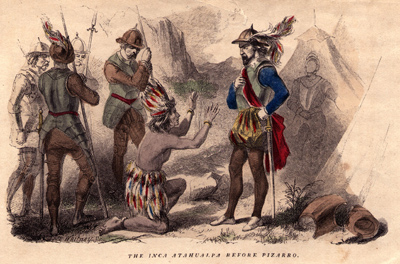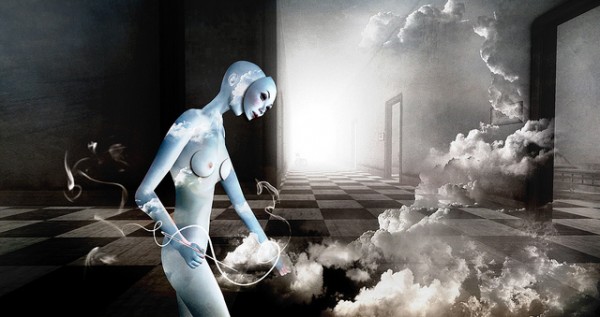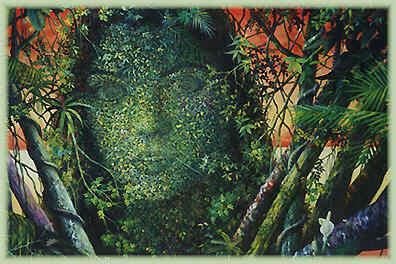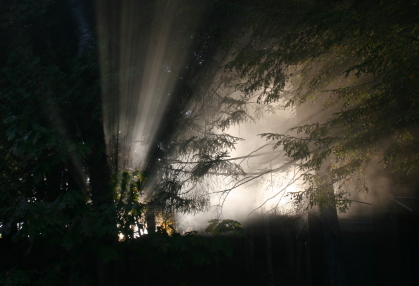
Although definitions vary depending on your culture and the strength of your resistance towards the transpersonal, most call lucid dreaming the experience of dreaming with awareness, and sometimes dreaming with control, while the body sleeps. With the buzz around Inception, there have been more news articles about dream research in the last month than I’ve seen in the last two years combined, with every local journalist asking dream researchers the same questions: Is dream control possible — or is it science fiction? Will technology ever let us share dreams like virtual reality? What fool-proof methods or pills can we take to wake up in our dreams?
The truth is, these themes were perfected thousands of years ago by our ancestors, and are still practiced today in dozens of indigenous cultures around the world. And this work is done without pills, headsets, VR goggles, and dream machines. Lucid dreaming is actually a shamanic skill, a method of heightened awareness in the dream that allows healers, medicine men and soothsayers access to information, insight and energetic powers. Lucid dreaming doesn’t require technology: it is the technology.
Conquistadors of Consciousness
But this is a far cry from how we as Westerners are taught about lucid dreaming. More often than not, lucid dreaming is discussed as a fantasy realm where we can indulge our private fantasies, seeking entertainment and pleasure. Not that there’s anything wrong with this perspective, limited as it is. It’s simply a marketer’s dream seeking the lowest common denominator, neatly paralleling the adolescent cravings that drive the main engines of distraction and consumption in Western culture.
The fantasy “of all the sex you want,” as a creepy punk rock character from the movie Waking Life promises, has a darker side though. The roots of the idea reach straight into the colonial paradigm of Western civilization, where it is our noble right to seize what we want because our own desires are the only thing that matters in the dream — the dream ego is the only thing truly alive. “It’s just a dream, after all.”
 The dream as wilderness awaiting our plunder is an old myth that played out in the scientific West. For those who do grant that dreams have meaning at all, the meaning is seen as a resource to be extracted for our waking life goals. Even the father of modern depth psychology, Sigmund Freud, discusses dream interpretation as the work of culture to drain the swamps of the psyche to build monuments for the ego.1 On the other hand, Freud’s younger colleague Carl Jung warns that, “Any efforts to drill (the unconscious) are only apparently successful, and moreover are harmful to consciousness.” Unaware of this divide, but still caught in its net, many lucid dreaming 101 books promise unlimited potential: and all the possibilities sound vaguely like newspaper ads from the 19th century trying to call new frontiersmen into Indian country.3
The dream as wilderness awaiting our plunder is an old myth that played out in the scientific West. For those who do grant that dreams have meaning at all, the meaning is seen as a resource to be extracted for our waking life goals. Even the father of modern depth psychology, Sigmund Freud, discusses dream interpretation as the work of culture to drain the swamps of the psyche to build monuments for the ego.1 On the other hand, Freud’s younger colleague Carl Jung warns that, “Any efforts to drill (the unconscious) are only apparently successful, and moreover are harmful to consciousness.” Unaware of this divide, but still caught in its net, many lucid dreaming 101 books promise unlimited potential: and all the possibilities sound vaguely like newspaper ads from the 19th century trying to call new frontiersmen into Indian country.3
Explore, manipulate and conquer — the manifest destiny of lucid dreaming. This myth places the dreamer in the center of the world, the creator and arbiter of the dreaming landscape, and by default, before we even know it’s happened, we have become conquistadors of consciousness.
Beyond the Wilderness of Dreams
Of course, when explorers come to a “new” world, they quickly discover they are not alone. The ecologies of today, for better or worse, have been shaped by human hands for millennia. The wilderness myth comes with civilization. For all intents and purposes, the concept of wilderness has been useful politically, by allowing for the preservation of vast tracts of land (most of which were inconvenient to exploit in the first place, just sayin’), but the wilderness ideal has also sustained the dualism that humans have no place in the natural world. The dualism here therefore casts any use of nature to be ab-use, denying us “a middle ground in which responsible use and non-use might attain some kind of balanced, sustainable relationship,” according to American historian William Cronon.4
This myth continues to obstruct our view of dreams and other intuitive states of consciousness. Why? We do belong in nature, and we have an opportunity to belong in the dream as well with our analytical minds, self-awareness and active manifesting abilities fully intact. While at first the autonomous dream figures duck into the shadows due to the blinding light of lucidity (lucid comes from the Latin word for light, luce), they eventually emerge when the dreamer loses the adolescent drive to completely control the dream, and when the dreamer is ready to meet the dream on equal grounds.
Dream Control
To clarify, in my opinion, it is natural and healthy for beginning lucid dreamers to attempt to control aspects of the dream, just as a child tests limits with his parents. Early dreams of control can be empowering and ecstatic. Personally, I took to flying at the age of 14, and had my fair share of sensual lucid experiences too. There are other instances when dream control is culturally and psychologically appropriate, such as in the advanced Dream Yoga practices of Tibetan Buddhism or in the lucid dreaming therapy of trauma victims who use the lucid dream to re-script the damaging narrative that robs them of vitality.

But lucid dreaming is not the same as dream control. You can have meta-awareness without control, and you can manipulate the dream without knowing you’re in a dream at all. Both lucidity and control shift in quality at all times too, so a lucid dream can have some pretty un-lucid moments. And of course, so called “control dreams” are always full of material not consciously selected by the dream ego.
Anthropologist Michael Winkelman describes a more appropriate model of the sort of consciousness highlighted during lucid dreams as well as other altered states. He calls it shamanic consciousness, in which we are capable of holding the emotional vibrancy of the dreamworld simultaneously with the focus and volition that marks our waking lives.5 Remember, the dreamstate is still running the show despite having self-awareness, or what psychologists call formal self-reference, and this is the fuel for the shamanic fire.
Why Self-Awareness is Over-rated

From a scientific perspective, REM dreaming has a pretty specific neuro-phenomenology. Activation of the limbic system brings strong emotions, and this is combined with an enhanced access to long-term memory — and a depression of short-term memory so we don’t tend to question who or where we are. The parts of the brain that bring mental imagery are also actively firing away, creating symbolic structures for all this content. In a nutshell, dreaming is a potent mix of visual-emotional-linguistic metaphors that link to our deepest memories and experiences.6 So being aware during this intense process, a little activation of the prefrontal cortex, does not necessarily pull rank.
In the long run, dream control has a more limited role then suggested by the self-appointed gurus of lucid dreaming 101. Dream control, once it is integrated into a shamanic paradigm, is necessary to set intentions, to assist in dream body transformations, to make choices that are presented, and sometimes, to manifest what is missing in a dream narrative that asks for creative solutions. Remote viewing, distance healing and animal transformation (of the dreambody) are concrete expressions of the shamanic paradigm.
It is in this paradoxical state of consciousness, awake when asleep, that a second paradox can be achieved: to use the rational mind to invite mystery, and to use dream control to surrender. Only then do the deeper, more ancient possibilities of lucid dreaming reveal themselves.
Lucid Dreaming in Other Cultures
In many indigenous cultures around the world, dreaming is practiced as a shamanic art. Lucidity is not often discussed directly, but in many cases, the lucid-control dimension is evident in the dream reports collected by anthropologists. For many of the first people on the planet, being aware of being aware is not a trick for its own philosophical novelty, but a prerequisite for undertaking a dangerous dream journey. These dreams, marked by clarity, intense imagery and emotions, are invariably known as big dreams, and in most cultures are treated and interpreted differently than the dreams that reflect anxieties and everyday-life concerns.

One such extant lucid dreaming culture area is located within peninsular Malaysia, a grouping of indigenous cultures known as the Orang Asli. Anthropologist Diane Riboli suggests that shaman in these cultures use their dreams and vision states to shape-shift and retrieve information that they interpret as coming from outside their bodies.7 They transform into animals in order to gain power, protect individuals and villages, and communicate with the forest directly.
Dream hunting has also been reported by Hugh Brody, in his 1997 narrative Dreams and Maps.8 The skill is almost lost, according to the Beaver Indians living in the Canadian subarctic, and only a few elders still know the way. In short, the hunter dreams where the game is located, and in some cases, can even glimpse the particular animal that chooses to be sacrificed. In waking life, the hunters locate the game and respectfully make the kill.
Shamanic lucid dreaming is well known in South America, as well. Chilean anthropologist Rosa Anwandter suggests that there are over 20 dream-honoring societies in the Amazon basin and another half-dozen in Peru. One clear example is the Guarani peoples, who meet regularly in circle to share their dreams. The Guaranis of Paraguay also recognize lucid dreaming, and are said to move their villages based on dream warnings of future floods.9
Lucid Dreaming and Entheogens
These indigenous examples point towards a possible ecological function to lucid dreaming, similar in scope to the role of entheogenic plants in the Amazon, as reported by Jeremy Narby in his mind-blowing book The Cosmic Serpent, in which ayahuasca is a diagnostic tool used to discover which plants to prescribe for the shaman’s client.10 Read more about the links between lucid dreaming and the Cosmic Serpent here .

In both lucid dreaming and ayahuasca, the visionary feels lucid and self-aware while navigating a strange and numinous world. But perhaps there is more than metaphor here. Frank Echenhofer, a professor of clinical psychologist at the California Institute of Integral Studies, recently collaborated with noted ayahuasca researcher Luis Eduardo Luna to research the electrical output of the brain while under the influence of an ayahuasca brew.11 They discovered a pretty amazing effect: a strong synchrony in the frontal lobe over multiple frequency bands, specifically the high BETA and GAMMA range.
This same effect has been found recently by dream researcher Ursula Voss in lucid dreaming: a strong blip around the 40hz (GAMMA) wavelength that is not present in ordinary dreams.12 Other researchers13 have found a correlation between GAMMA and high levels of meditation.
Perhaps ayahuasca and lucid dreams are leading visionaries towards the same meeting grounds: where mind, body and spirit tether together in a bounded information exchange for the benefit of the community, and perhaps the ecosystem, as a whole.
On the topic of lucid dreaming and entheogens, Native American healer Rolling Thunder suggests, in a 2004 interview by psychologist Stan Krippner, that lucid dreaming is a preferable way to access the hidden realms of reality, provided the practitioner knows the intent and direction of the journey.14 Lucid dreaming is more reliable, easier to enter into, less confusing, and does not require access to plants or substances that are only seasonably available.

A brief aside of archaeological speculation: given that lucid dreams upwards of 10 minutes and longer have similar kinds of imagery as do meditative states and shamanic reverie, such as geometric imagery, mandalas, spirals, zig-zags, white light and half-human-half-animal creatures,15 there’s an argument to be made that some of the world’s prehistoric rock art could be the product of lucid archetypal dreams rather than psychedelic drugs, as it is often presupposed by archaeologists, many of whom are unaware of the spectrum of possibilities in lucid dreams. As cognitive archaeologist David Lewis-Williams argues in The Mind in the Cave, humans cannot refrain from dreaming.16 It’s a neurological constant, our shamanic dreaming inheritance, and has been for at least a hundred thousand years. How we select for, use, and learn from these images, of course, differs from culture to culture, and individual to individual.
Lucid Dreaming Shamanism for Westerners
We don’t have to be indigenous peoples to appreciate the shamanic aspects of lucid dreaming, but as Westerners we may need to let go of some destructive myths in order to participate at the deeper levels of imagination like those cultivated in dreaming cultures. Some of these myths include the idea that we as individuals are alone, we as a culture are owners of the lands we inhabit, we as a species are separate from nature, and that the universe itself is a dead, mechanistic realm of cause and effect. When we take these notions into the dream, the stages is set, the possibilities are limited and the anomalies are stamped out before they have a chance to speak up.
However, simply donning the cultures of others has its limitations, as well as hidden power dynamics that derive from those same colonial attitudes that reflect our disenfranchisement from spirit in the first place. In his book Dreamseekers, world traveler Harvey Arden writes about the way indigenous cultures feel drained by Westerner’s appropriation of their healing ways. One young aboriginal man fumes, “Get your own Dreamtime. Don’t take ours.”17
In answer to this dilemma, Tom Crockett, author of Stone Age Wisdom, suggests a culturally neutral framework of dream shamanism that allows us to benefit from our own intellectual traditions as well as the pre-rational wisdom traditions.

By remembering principles from our own deep indigenous heritages — and we all have one or more — we can tap into the dream directly. Some of the principles Crockett maps are that the “universe is alive, conscious, dynamic, interconnected, and responsive.”18 Enacted within the lucid dream, and mirrored in waking life, these principles can help heal the wound of the western lucid dreamer who wants to move beyond control in order to communicate with other sources of identity, wisdom and sentience. When I began exploring the ancestral connection to lucid dreaming, it was a box of Lucky Charms that presented itself first. Further dreams helped me move beyond stereotypes of my Irish heritage into deeper connections with my Celtic ancestry.
Researching into the cosmologies of our direct ancestors in the historical era can also provide a quick path into dream shamanism, as these ways are still half-remembered. The road has simply been covered by few feet of mono-cultural plastic debris whose gods are industry and ecological warfare. But the older path is still laid, hidden in the dreams, folklore and colloquialisms of our families of origin.
Our beliefs and expectations shape lucid dreams, including the limits of dream architecture itself. With an attitude of awareness, humility, and a desire for interconnection with the autonomous energies of the dream, the dream expands. Mutual dreaming, precognition and healing become accessible.
The Military-industrial Complex and the Dark Side of Lucid Dreaming
Ominously enough, the US military has done extensive research into remote viewing, which is the application of deep imagination, trance or dreams to discover information about a place, person or event. Shamans call this technique soul-flight, and it’s also known as out-of-body experience and astral travel. The movie The Men Who Stare at Goats is a loose adaptation of the remove viewing work that went on in the US intelligence community for over twenty years to determine the usefulness of remote viewing in order to receive information about a target. Chris Nolan’s Inception also draws from this heritage with its fictional Project Somnacin, a government task force uses lucid dreaming as psi-ops.

This work is now declassified. Officially the US government professed that there is no benefit to remote viewing in 1995. However, the various programs, with names like “Stargate,” “Gondala Wish,” and “Sunstreak” had some convincing documented successes, according to ex-Stargate chief Dale Graff in his book Tracks in the Psychic Wilderness, including the location of a downed Soviet TU-22 airplane by remote viewing.19
Which brings me to the point that lucid dreaming and active imagination of this level requires practice and competency, but not necessarily allegiance to some higher benign power like Gaian consciousness. Shamanism is rife with healers competing with one another, casting spells and throwing sickness barbs of retro-causality, as reported by Stephan Beyer in his book Singing to the Plants. 20 Lucid dreaming is no different. And as Robert Waggoner points out, mutual lucid dreaming opens the door to not only shared dreams, but also real dream intrusion a la Inception — without the need for a narcotic dripline.
Spiritual Emergence
Contrary to pop-psych common sense, lucid dreams can be destabilizing for the dreamer, and can open doors into pain and confusion. Sometimes knowing you are dreaming does not stop the nightmare from being uncomfortably gritty. Confronting dark material of the unconscious, the culture — or beyond — in lucid dreams can be a symptom of spiritual emergency, a diagnostic category in the latest diagnostic manual for the American Psychiatric Association that involves mental instability due to existential and spiritual distress. These dreams come at stressful times in our lives, and also at life cross-roads as we bridge from one role to another and take on new responsibilities. In confrontational lucid nightmares, fear is not a failure of the dreamer. Psychotherapist Scott Sparrow, a long-time lucid dreamer, suggests instead that the presence of fear in the lucid dream is justified: it is the first step of recognizing a worthy adversary.21
In my own lucid journeys, I had bouts of painful intestinal cramping for weeks on end while engaging in a lucid dreaming incubation practice for three months. These dreams involved a lot of spontaneous childhood memories and confrontational dream figures. Metaphorically, you could say I was having trouble digesting what I was experiencing. Veteran lucid dreamer and psychotherapist Ken Kelzer also describes negative physical and psychological symptoms in his classic lucid memoir The Sun and the Shadow.22 The serious lucid dreaming journeyer should take pains to establish the set and setting, just as experienced consciousness explorers do with entheogenic healing sessions.
Ask yourself: do I have a safe living space for this kind of work? Is this a stable time in my life to be taking these risks? Who can I turn to-a guide, minister, therapist or coach who has walked this path as well-if I need help?
The Initiation

We really shouldn’t be surprised that lucid dreaming is not all cotton candy and light once the veil has been lifted and a respectful balance between awareness and control is met in the dream, allowing for a true meeting with autonomous entities and titanic forces. In a real way, these dreams can be seen as private initiations. Common themes in lucid nightmares of Westerners involve pain, death and rebirth, as well as images of demons, dead bodies and hell-like scenery, directly analogous to the shamanic initiation dreams that are recorded around the world by ethnographers. These expressions are truly archetypal, coming out of the body’s metaphoric drive to express its essence, and also connecting us to a larger community of archetypal energies in the world-at-large.
Here’s an example of what I would call an initiatory lucid dream that begun as a sleep paralysis nightmare, shared with me by a woman dreamer who lives in the Middle East, published in my ebook Sleep Paralysis: A Dreamer’s Guide.
I was reading for a while, then I noticed that the wall (about 6 feet from the end of my bed) started to sort of wobble. My body was paralyzed, unable to move. My breathing was kind of non-existent, though I desperately needed more air. Suddenly, it opened up into a black void. Like a 9 ft black hole, vaguely the shape of a figure. “O my god,” I thought, “I am dreaming. This can’t be true.” The black-hole oozed into the room. I was beyond terror. I still don’t understand how my heart didn’t collapse. The blackness started molding itself into a recognizable shape. It became a 9 ft tall Japanese devil or devilish-looking Samurai. Viciously grinning he said, “You are not dreaming. You thought you could ‘integrate me.'” He then, in one sweeping movement, stretched out his enormous black hand, grabbed me, stuffed me into his blood-red mouth, and swallowed me. Then I fell into unconsciousness for a moment, now a vortex pulled me down into an abyss of no dimensions. All of a sudden, I was spat back out into his hand. Somehow, I had crystallized into a red ruby. I WAS a ruby; I felt like a ruby. So there I was, in the big hand of a giant, looking at him, and he looking at me. In that moment-seeing each other-something happened. We looked at each other, became truly aware of each other, and then, there was love. I know what the mystics talk about/can’t talk about. There is believing, and then, there is knowing.23
I am particularly delighted how the dreamer’s demon scoffed at her paradigm of “integration.” As depth psychologist James Hillman has suggested in The dream and the underworld, our dream figures are not simply representations of our personality traits — the demon as carnality or as power — but complex self-like constellations with their own interiority and their own sentience.24 And often, their own agendas, contrary to the dream ego. In this case, by surrendering to the death of her dream body and facing an abyss, the dreamer was reborn as a ruby with a profound new understanding.
Lucid Dreaming as Revolution

Dream control can be used to surrender and go with the flow. This tension between maintaining awareness and dancing with the unknown is the thin line that connects us to the source(s), leading us into a light brighter than our own lucidity. At this time in history, the ability of dreamers to tap into the wisdom of the ancients and to draw from the intelligence of non-human sources may be critical to our survival, at least for the dream’s ability to make conscious what is happening in the world, in each of our communities, due to the ecological effects of civilization.
Anthropologist Lee Irwin has showcased how, during Native American clashing with the colonial West in the 17-19th centuries, big dreams and waking visions integrated conflicting paradigms and opposing worldviews, leading to the rise of healing visionary leaders who were able to organize and lead rebellions against colonial forces.25 Barbara Tedlock (1992) also recounts this revolutionary role of dreams in Mayan cultural survival during the Guatemalan civil war in the 1980s.26 In this case, the big dreams of indigenous community leaders showed the path for preserving traditional ways as well as accepting new cultural standards that are critical for participating in new economies.
Having the dream does not guarantee success, as the history of Native American visionary apocalypticism tragically reveals, but it can provide a new template for survival against great odds. In this techno-militaristic world culture that is coming to grips with its own limitations, but not yet the scope of its destructive power, I have a feeling this dreaming art is on the upswing. But only if we remember our dreams, share them, and act from them with eyes and hearts wide open.
This article is adapted from an article I wrote originally for Reality Sandwich, a magazine for consciousness expansion founded by Daniel Pinchbeck, author of 2012 and Breaking Open the Head. As such, it’s pretty much a synthesis of my thoughts on lucid dreaming to date. I welcome all comments!
First image CC: Abstract Vortex by Renzo Ferrante
Footnotes:
1 Freud, Sigmund (1965). New introductory lectures on psychoanalysis. W.W. Norton & Company, p. 71.
2Jung, Carl (1974). Dreams. Princeton: Princeton University Press, p. 120.
3An exception to this trend is Robert Waggoner’s excellent Lucid dreaming: gateway to the inner self. (2009).
4 Cronon, William (1996). The trouble with wilderness. In Uncommon ground. Norton Publishers, p. 86.
5 Winkelman, Michael (2000). Shamanism: the neural ecology of consciousness and healing. Bergin and Garvey.
6 See Harry Hunt’s Multiplicity of Dreams for his amazing interdisciplinary synthesis of dreaming; I also draw from Allan Hobson’s 2003 work Dreaming: an introduction to the science of sleep.
7 Riboli, Diane (2008). Tigers, flowers, halak and jampi: Interchanges and permeability between human, animal and plant spirits in Semang-Negrito (Peninsular Malaysia) shamanism. Presentation at the annual conference for the Society for the Anthropology of Consciousness, New Haven, CT. March 20, 2008.
8Brody, Hugh (1997). Maps and dreams. Waveland Press.
9Anwandter, Rosa (2008). Dream societies in South America. Presentation for the annual conference of the International Association of the Study of Dreams. July 12, 2008, Montreal, Quebec.
10Narby, Jeremy (1998). The cosmic serpent. Putnam Press.
11 Echenhoer, Frank (2010). The dynamics of healing and creativity during ayahuasca shamanic journeys. Presentation at the annual conference for the Society for the Anthropology of Consciousness, Berkeley, CA, March 20, 2010.
12 Voss, U., Holzmann, R., Tuin., Hobson, J.A. (2009). Lucid dreaming: a state of consciousness with features of both waking and non-lucid dreaming. Sleep 32(9) September 2009.
13 Lutz, A., Greishar, L., Rawlings, N., Ricar, M., Davidson, R.J. (2004). Long-term meditators self-induce high-amplitude gamma synchrony during mental practice. Proceedings National Academy Science, USA 101(46), pp. 16369-16373.
14Krippner, Stanley (2004). The psychology of shamans and shamanism. Dreamtime, 21(1), pp. 10-12.
15 Hunt, Harry (1989). The multiplicity of dreams. Yale University Press, p. 121-122.
16Lewis-Williams, David (2002). The mind in the cave. Thames and Hudson.
17Harvey Arden (1995). Dreamkeepers: a spirit-journey into Aboriginal Australia. HarperCollins, p. 3.
18Crockett, Tom (2003). Stone age wisdom. Fair Winds Press.
19Graff, Dale (2000). Tracks in the psychic wilderness. Element Books.
20Beyer, Stephan (2009). Singing to the plants. University of New Mexico Press.
21Sparrow, Scott (2010). Lucid dreaming: transcendence and transformation. Presentation for the annual conference of the International Association of the Study of Dreams, July 1, 2010, Asheville, NC.
22Kelzer, Ken (1987). The sun and the shadow: my experiment with lucid dreaming. A.R.E. Press.
23Hurd, Ryan (2010). Sleep paralysis: A dreamer’s guide.
24 Hillman, James (1979). The dream and the underworld. Harper and Row.
25 Irwin, Lee (2008). Coming down from above: prophecy, resistance, and renewal in Native American religions. University of Oklahoma Press.
26 Tedlock, Barbara (1992). The role of dreams and visionary narratives in Mayan cultural survival. Ethos, 20(4), pp. 453-476.
Thanks for your interesting article, Ryan. I have to read some of your mentioned books about (lucid) dreaming in other cultures.
In my own studies I found it often difficult to decide whether dream reports from other cultures contain lucidity or not, or rather something in between.
The focus on the aspect of lucidity is from our western perspective. And since native dreamers do often not explicitly mention this aspect you have to look at the context and the whole believe system to get to know more about lucidity in dreams.
I might add that also in Papua New Guinea dreams are highly valued, as shown in many books and articles (for example Dream Travelers—Sleep Expereriences and Culture in the Western Pacific (2003), ed. Roger I. Lohmann and Michele Stephen’s A’aisa’s Gifts (1995)), because
“[they] are regarded as highly important religious experiences in many Melanesian
societies. Because they provide a means of direct communication with the realm of
divine power – the ancestors, deities and spirits – dreams are a source of supra-human
knowledge and power; they reveal knowledge of the past, and of the future, of
new techniques and skills, and inventions.“ [Stephen 1979:9]
In many Melanesian societies spirits reveal information, such as warnings of death, sickness or witchcraft, advices for problem solving or healing, the likely development of events, or ritual knowledge.
These spirits can be ghosts of the dead, mythological beings or christian figures and not only ritual experts have the abilities to communicate with them. Interestingly, also “ordinary people” have contact with spirits in dreams and are able to act consciously sometimes, if not with the same depth as the ritual experts, for whom lucidity seems to be a necessary aspect for dealing with the not always benign spirits they meet in dreams.
I hope this was of interest.
Sorry for any mistakes, English is not my native language.
Thanks again for your great work on this website!
Stephen, Michele
1979 Dreams of Change: The Innovative Role of Altered States of Consciousness in Traditional Melanesian Religion. Oceania 50:3-22.
hi Mark, thanks for the warm words and also the reminder: lucidity really is a culturally-relative term. Even the way we experience waking and sleeping and dreaming is different — for instance in many cultures waking dreams “visions” are normal, and not a sign of insanity as in the West because there is cultural support and framework for how to work with these states of consciousness.
And also thanks for pointing out that you don’t have to be a shaman to use lucid dreams for healing. Recent studies are showing that lucid dreams are more common than previously thought. On the other hand, I would never suggest that lucid dreamers are shaman simply because they lucid dream. Being a shaman is a culturally-sanctioned role, not a skill roster.
I have read Dream Travelers and also highly recommend it. it’s pretty academic but a good resource. religion scholar Serinity Young’s work with Buddhism and dreams is also great. “Dreaming in the lotus” is the title.
thanks again for commenting. your English is very good!
Another great article, Ryan. Thanks for the link on “Spiritual emergency” — who knew?
Nan, it’s time for spiritual emergence/emergency to be a household word, in my opinion. these openings happen to modern people but we don’t have much of a cultural framework to support its psychological trajectory.
more info:
http://www.alternativesmagazine.com/08/levy1.html (an amazing personal account)
and here’s David Lukoff on youtube: http://www.youtube.com/watch?v=86OiKLHRmsk
It’s great to read something so clear and incisive on a topic that can seem mysterious or obscure.
thanks Zoe. your blog is excellent as well — not too many informative and professional blogs on contemporary shamanism, especially from UK perspective and heritage — glad to meet another ally.
Thanks for additional info.
This article has massive good potential in the lucid dreamers´ World.
Thanks Ryan
Once again, a superb article. Spiritual emergence/emergency is a transpersonal psychology term I believe, first used in that modality… please correct me if I’m wrong. It’s about time that it is included!
Thanks Ryan
Loving your work!!
thanks Dreampurr and Fernando for your kind words! I got pretty fired up at the end about the dreamer’s revolution. That’s another subject that’s on the slowcooker right now.
Um. BRILLIANT.
My dream life has sort of “taken off” lately, at about the time I began trying to connect with my ancestors in a way beyond statistical analysis. I think your words will prove helpful.
Thank you.
thanks Amber. You probably know about Erin Langely’s lucid dreaming project, but others may want to check it out as well as she explores ancestral lucid dreaming and “lucid dreaming for the earth.”
http://luciddreamconservationproject.blogspot.com/
Hello Ryan,
Thank you for the article.
any good resources on dreams in steppe shamanism?
Thank you
hey Alex,
to be honest I know very little about this dreaming culture, besides that dreaming is a path to ancestral wisdom and healing.
However, I believe Barbara Tedlock discusses women shaman-dreamers in Mongolia in her book The Woman in the Shaman’s Body.
I’ve also heard good things about the documentary Khadak altho I haven’t seen it yet.
For general shamanic resources, I recommend:
http://shamanism.org
http://www.shamanismconference.org/
An amazing site! I’m happy I found it, I’m very interested in developing higher dreaming skills.
Will you write about spirituality and moral development, as well? I think it’s crucial not to fool ourselves and live in absolute truth in order to dream at fullest and make the dreams talk to you.
Ack! Where did this article go? The title is so enticing yet the content has just plum disappeared. Any chance of getting it re-posted?
hey Steven — it’s back!
Superb. Thank you.
thank you Ferran! I talk more about lucid dreaming in context for Westerners here — a podcast that just published today: http://www.iamubermensch.com/all/episode-19-ryan-hurd-part-1-lucid-immersion-blueprint/
Excellent also. Your book (Immersion Guidebook) looks interesting: is it available in the United Kingdom? Thanks.
Ryan, I also wondered whether you can recommend any good books on Hypnagogia (not necessarily sleep paralysis). I read Mavromatis’s excellent book on the subject a while back, but wonder if there is anything of that calibre you might be able to recommend.
Hey Ferran, Mavromatis’s book is still the single best reference on the topic. No other volume comes close in my opinion.
and yes! My ebook should show up on the UK Amazon page — search for my name and Lucid Immersion.
Will do. Thanks, Ryan.
interesting article. if you would answer to this i would be very happy. i haven’t had a dream in years (at least i remember none) why is that? and i remember the most terrifying dream as a kid, alone in the dark in a circle of light for what looked like days i don’t know why i was terrified.
Hi Dan, it’s pretty common to not remember your dreams in this day and age. You can download my free ebook on how to remember more dreams here: http://dreamstudies.org/subscribe-to-dreamstudies/
Hi 🙂
This essay is the best I’ve read in ages.
Can you recommend a dream/shamanic resource for a white, middle-aged Canadian woman (myself) to utilize?
The dreams that I engage in are fantastic and manageable, for the most part, but they are sometimes too challenging. I need some guidance. I’ve explored such sources as Casteneda, Jung, Campbell, and have avoided like the ‘flu dream dictionaries.
Thanks for your time.
Regards, Tanya